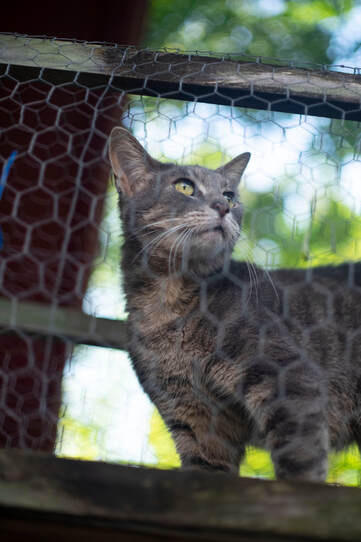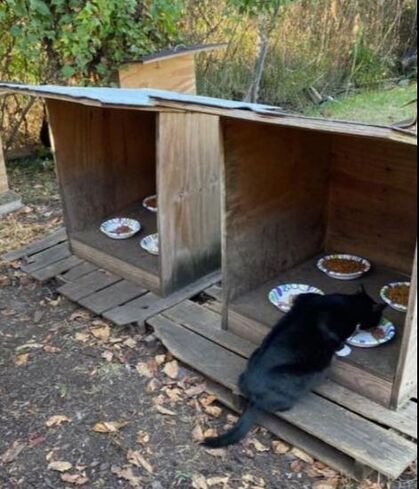Common Complaints About Community Cats
and How to Alleviate Problems

Depending on the size of the colony, you may need to address some concerns from one or more of your neighbors. By addressing any specific concerns and showing that you want what is best for the cats and your neighbors, you may be able to defuse many common conflicts.
The most common complaints about community cats include the soiling of lawns or gardens, the late-night yowling, the leftover food scraps attracting wildlife, the sight of kittens and sickly cats, the unpleasantness of dirty feeding areas, and sometimes just the fact that free-roaming cats are around. A cat caretaker can alleviate many of these problems and concerns.
Talk to Your Neighbors
Preventing Problems with Neighbors
The most common complaints about community cats include the soiling of lawns or gardens, the late-night yowling, the leftover food scraps attracting wildlife, the sight of kittens and sickly cats, the unpleasantness of dirty feeding areas, and sometimes just the fact that free-roaming cats are around. A cat caretaker can alleviate many of these problems and concerns.
Talk to Your Neighbors
- First and foremost, it is critical that you open a friendly dialogue with your neighbors. Rather than being emotional and angry, appear reasonable and professional, even if your neighbors are not. This will give them confidence that you know what you are doing and that you care about their concerns.
- Let them know that you did not create this situation; the cats are there because someone else failed to sterilize a pet cat, abandoned the cat, or the cat became lost.
- Explain the benefits of TNR and the ineffectiveness of eradication. It may be helpful to point out that the end goal of TNR is also to ultimately reduce the homeless cat population, but through more humane methods. Sterilizing cats also drastically reduces nuisance behaviors and susceptibility to certain diseases on top of the standard vaccinations, which are two of the greatest causes for complaint.
- You may also want to call a community meeting or gathering of concerned neighbors to discuss the situation and possible solutions. They may be more comfortable when they learn that groups across the country and around the world are implementing TNR programs.
Preventing Problems with Neighbors
- All cats should be spayed or neutered to prevent the noisy and objectionable breeding behavior that neighbors dislike: yowling, spraying, fighting, excessive roaming, and endless litters of kittens.
- Make sure cats are vaccinated against rabies to alleviate health concerns. Immediately retrap and vet any cats who become ill or injured. Maintain good vet records, including a rabies tag number for each vaccinated cat. Be sure your cats are ear-tipped so neighbors can easily identify cats who are sterilized, vaccinated, and cared for.
- Clean areas where urine has been sprayed. White vinegar or Nature’s Miracle can eliminate any odors or staining. Cats will continue to spray in an area that smells of urine. Avoid using ammonia products; they smell so similar to cat urine that they may encourage more spraying.
- To prevent cats from soiling neighbors’ yards and gardens, dump play sand in an out-of-the-way area, or in covered wooden litter boxes that can be built outdoors at the colony site. Scoop daily to keep sand boxes clean and use baking soda to prevent odor.

- Keep food areas clean. Pick up any and all trash regularly. Remove empty food bowls, old dried-up food, dirty bedding materials, etc. Make the area as attractive and clean-looking as possible. Never leave cans lying around; they are not only an eyesore, but also attract flies and other animals to the area.
- Make sure garbage cans are secured to prevent cats (as well as other mid-size animals like raccoons and possums) from scavenging through them.
- If neighbors object to a specific feeding area, gradually move the feeding station to a new area a few yards away; the cats will follow the food. Create a small, partially enclosed feeding site to make food and water bowls, as well as cats, less visible; hide it behind or under bushes.
- To keep from attracting wildlife, feed only in the morning or daylight hours when raccoons and other wild animals are not active. Cats will quickly adjust to the new schedule. Again, be sure to remove leftover food after feeding.
- Keep bird feeders away from dense foliage where cats could lie in wait. Ideally they should be posted or hung at least 8 feet off the ground and 8 feet away from any climbable surface (like a tree trunk or balcony) in any direction to prevent cats from preying on the birds there.
- Try to make the shelters you have erected look clean and unobtrusive. Shelters and feeding stations can be painted in natural colors, like dark green and brown, to blend in with surrounding foliage.
- If fleas are a concern, treat feral cats with a topical flea product, like Advantage Multi, when you trap the cats. Be sure to change bedding material or hay in shelters regularly. Try sprinkling a non-toxic herbal flea powder, like Diatomaceous Earth, beneath the bedding. There are also oral flea treatments that can be crushed into food, but use caution to make sure that a cat eats only one dose.
- If neighbors complain about cats walking on their cars or possibly spraying on their tires, offer to buy a car cover to protect their vehicle.
Neighbors may have other, more pressing concerns as well. In the case of allergies, conflicts with pets, etc., there are a large number of deterrents that you can use to divert cats from areas where they are not welcome.
Cat Deterrents
- Push Cat Scat mats into flower beds and gardens to prevent digging. These plastic mats can be cut to fit any size area and consist of flexible plastic spikes that are unpleasant for cats to walk on.
- Cover exposed ground in flower beds with large attractive river rocks to prevent cats from digging. Rocks have the added benefit of deterring weeds and beautifying the landscape.
- Cats dislike citrus smells. Scatter orange and lemon peels or spray a citrus-scented solution on areas you don’t want cats. You can also scatter citrus-scented pet bedding such as Citrafresh. Or try using lavender oil, lemongrass oil, citronella oil, eucalyptus oil, and mustard oil.
- Cat Repellent Clips are biodegradable clips filled with a blend of natural, organic garlic, citronella, lemongrass, and cinnamon oils. These clips can be placed anywhere you don’t want cats, like in gardens or flower beds. Clip onto plants and shrubs that cats tend to nibble the leaves of. These clips safely and effectively repel cats for six to eight months.
- Use a cat repellent spray (available at pet supply stores) around the edges of the yard, the top of fences, and on any favorite digging areas or plants.
- Try an ultrasonic animal repellent, which emits high-frequency noise inaudible to humans. Cats find the noise to be an extremely loud and annoying alarm, repelling them from the area. These devices are available at lawn and garden stores.
- Use a motion-activated sprinkler, such as the Scarecrow sprinkler. Any cat coming into the yard will be sprayed but unharmed, and it is good for the lawn. These are also available at lawn and garden stores.
- Reppers Outdoor Sticks (from Beaphar) contain a cat repellent. These repellent sticks are nontoxic to plants, mammals, and humans and can safely keep animals out of your garden, flower beds, or potted plants for up to 60 days. These repellent sticks have been tested and proven to work by Alley Cat Rescue staff and neighbors!

- Push wooden chopsticks or 10-inch plant stakes into flowerbeds every eight inches to discourage digging and scratching.
- Cat-proof fencing is often used to keep cats from escaping an area, but it can also be used to keep them out of an area by pointing the slanted top of the fencing outwards instead of in. Some companies such as Oscillot also make extensions for existing fences, which will harmlessly deflect cats attempting to climb on them, and which may prove a more economical option than replacing all of the fencing around a property.
References
Burling, Amie N., et al. “Seroprevalences of Feline Leukemia Virus and Feline Immunodeficiency Virus Infection in Cats in the United States and Canada and Risk Factors for Seropositivity.” Journal of the American Veterinary Medical Association, vol. 251, no. 2, 15 July 2017, pp. 187–194., https://doi.org/10.2460/javma.251.2.187.
Ireland, Timothy, and Rachael Miller Neilan. “A Spatial Agent-Based Model of Feral Cats and Analysis of Population and Nuisance Controls.” Ecological Modelling, vol. 337, 10 Oct. 2016, pp. 123–136., https://doi.org/10.1016/j.ecolmodel.2016.06.014.
Kortis, Bryan. “Blog: Responding to Complaints about Community Cats.” HumanePro, The Humane Society of the United States, 10 Aug. 2022, https://humanepro.org/blog/blog-responding-complaints-about-community-cats.
Burling, Amie N., et al. “Seroprevalences of Feline Leukemia Virus and Feline Immunodeficiency Virus Infection in Cats in the United States and Canada and Risk Factors for Seropositivity.” Journal of the American Veterinary Medical Association, vol. 251, no. 2, 15 July 2017, pp. 187–194., https://doi.org/10.2460/javma.251.2.187.
Ireland, Timothy, and Rachael Miller Neilan. “A Spatial Agent-Based Model of Feral Cats and Analysis of Population and Nuisance Controls.” Ecological Modelling, vol. 337, 10 Oct. 2016, pp. 123–136., https://doi.org/10.1016/j.ecolmodel.2016.06.014.
Kortis, Bryan. “Blog: Responding to Complaints about Community Cats.” HumanePro, The Humane Society of the United States, 10 Aug. 2022, https://humanepro.org/blog/blog-responding-complaints-about-community-cats.